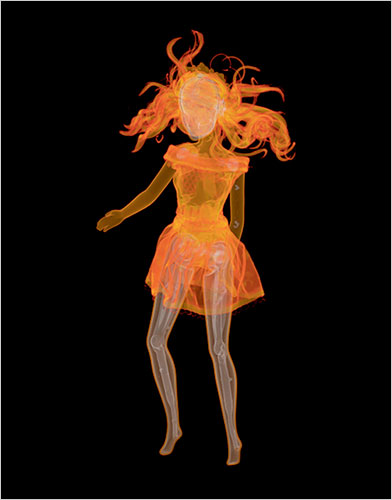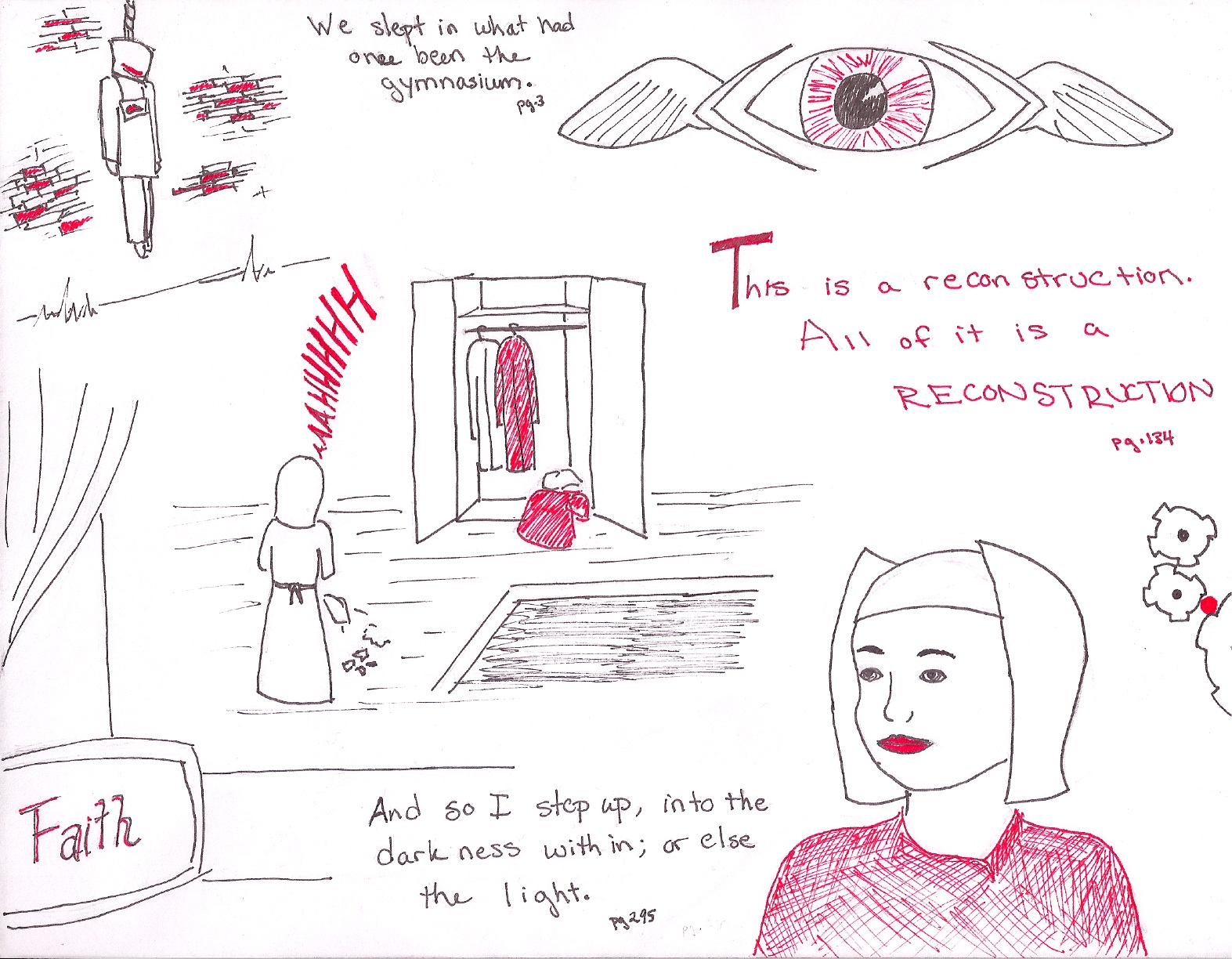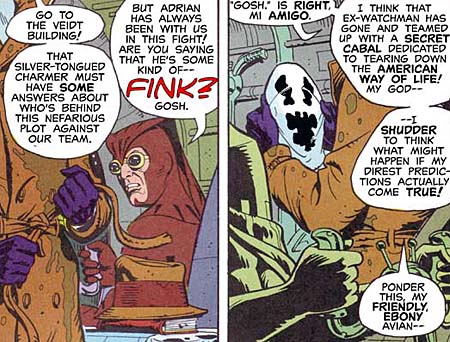Notes Towards Day 18: Who’s Watching the Watchmen?

Quis custodiet ipsos custodes?
(from the Roman poet Juvenal, about
where the ultimate power should lie)
Gather into groups around your favorite superhero:
The Comedian–> Nat
Doctor Manhattan
Nite Owl II –> Alex M.
Ozymandias
Rorschach –> Cat
Silk Spectre
Sally Jupiter –> Aline
“the psychiatrist”
I. Coursekeeping
Radical trans/queer activist Julia Serano in Thomas 223 @ 3:30 today
(excused if you blog about it right after!)
Third set of papers due this Friday @ 5
We are switching writing groups;
esp. imp’t to provide history of earlier work to your new responder!
If you are submitting this week’s assignment to Anne, I want
the “commented” versions of both the papers you wrote for Laura;
if you are submitting to Laura, she wants you to e-mail her Anne’s on-line comments on both earlier papers.
coupla’ other reminders:
any topic of “representation” okay—>doesn’t have to be about
Metropolis, The Handmaid’s Tale (1 or 2) or Watchmen—>
but it needs to arise out of our conversation and feed back into it

for example, Sugar Spice’s discovery of Barbie CT Scans…
what do we see, that we couldn’t see
w/out such technological assistance,
in a colored x-ray vision of familiar objects?
is the activity purely aesthetic, or….?
happy (not required) to have a conference,
help you brainstorm/think through a topic–
or form of presentation
(very struck by JS, Hillary, Rebecca‘s visual offerings this week):



Since this has been a unit on (self-conscious) representation,
you should be self-conscious about the ways in which you
choose to represent your ideas in this paper:
Think about multiple/alternative forms of
argumentation, including the visual…
could write about these/other works, using images,
could write about issue raised by works, using images,
could (a la Hillary, Rebecca) create your own images,
w/ caveat that they need explication,
don’t speak for themselves (as per Watchman:
text of commentary @ end of each chapter)….
One more short project due, @ end of fourth section of course;
then large final project, 10-12pp. (or equivalent)—> this will need to
grow out of what you’ve done before, and emerge from a
writing conference w/ us about the range of possibilities you’ve
given yourself so far. So: one way to think about this week’s project:
as a warm-up for finale; getting ready for bigger work.
Review instructions for posting @ “Web Papers”
and/or “Syllabus: Paper Assignments.”
While we are talking about requirements,
take opportunity to review what we are expecting of you;
a number of you are not meeting class requirements
(because we’re not slapping on/handing out grades?);
nothing mysterious here, and we’re not counting/policing—>
but you should be paying attention;
missing classes or not posting-as-we-go
can’t be made up @ the end.
II. Summary/Review of last week’s discussion
of The Handmaid’s Tale (the movie, with images):
Laura’s overview focused on all the
“opportunities for ironic awareness”
lost in the movie-making:
The soap-opera ending, throwing away the
historical conference as framing advice–>
the film was missing the metafictional strategies
the novel used to remind us that the
mechanisms of surveillance represented in the novel
can NOT be evaded, that there are NO places safely unreachable…
Rather: the movie allowed us to safely “put away”
the story when we walk out of the theater; it was cathartic
in a way the novel refused to be.
That was a conservative, “escapist” gesture (in relation to historical dynamics) that violated the insistence of the novel that we should be suspicious of any resolution.
(Cf. NYTimes article, “What kind of movies do we need now?”)
All your “pitches” followed this advice, trying for
something more unsettling, dislocating
(most explicitly in D.C.’s group, which added a
plot line about repressing male homosexuality);
but all of you did this formally, w/ voiceovers,
multiple plot lines, animation, tight shots, reverse shots,
constricting the world to Offred’s point of view (with wings on side–echoes of The Diving Bell and Butterfly).
Thinking about Guinevere’s question–
how to apply/enact what we are doing here outside here
(or: what difference does it make?):
what I got from Wednesday’s exercise was an
awareness of the constructedness of reality,
our ability to make multiple stories about what’s happening,
to always tell a different story, and to know that it is one of many
(that is, to be self-conscious about our storytelling);
vs. the cultural predilection to seek out/
construct escapist representations,
your films were willing to play with forms of unreliable narration.
Comments on any of that…?
III. That was the frame–>
unreliable narration– that I brought to Watchmen.
Horrified, disgusted, hated looking @ the images (all that blood…)
But: rich site for analysis, learned a lot trying to make sense of it/
think through what it was doing, how it operated on me,
why you all are so drawn to it (there is a generational gap here!).
Very interested in the booming new category: genre of graphic novels
(first written, published in installments as comic books);
a great test case for last week’s questions about the
different ways words and images work on us/
how we process images differently from words,
moving images differently from static ones
(as well as good test case for thinking about how it
would work differently as novel or film).
Great study both of visual representation and of
the relation between medium and message.
Here are your questions:
A. How do/should you read a graphic novel?
Genre is about expectation:
what do you expect a graphic novel to do, and how?
What does it do to teach us to read it?
(Much slower than I expected: can’t skim!)
B. What relation is there between this technology and gender?
(Question Rebecca asked last month,
w/ answers from Simran, Ruth, Solomon, George…)
What connections can we make between genre-and-gender,
between the generic predilections and the gender positions
of the (presumed) readers of Watchmen?
GENS
A clan or sect; a number of families united by the ties of a supposed common origin, a common name, and common religious rites. Hence employed to designate any similar aggregation of families.
GENRE
Kind; sort; style.
A particular style or category of works of art; esp. a type of literary work characterized by a particular form, style, or purpose.
GENDER
Kind, sort, class; also, genus as opposed to species.
the general gender: the common sort (of people).
So: what is this “gens”? What “genre”? What “gender”?
C. What is its relation, more generally, to the world it represents?
Baibh: the idea that someone knows moral right and wrong in absolute and immutable terms is what attracts people towards attempting to create a utopia: the point of books like Watchmen, THT, etc. is that it’s easier to make blanket statements for quick and easy comprehension
Ruth: we’ve got a problem with otherizing urban poverty
NYTimes movie reviewer called out:
* themes of apocalypse and decay (dank, downcast)
* anachronistic, nostalgic orientation
(product of its moment: cold war America)
* shallow nihilism (only thing that makes sense is killing)
* immature, adolescent belligerence
* “dense involution of narrative”
* self-conscious critique of the national preoccupation
with muscled, masked crime-fighters
Especially interested in Watchmen because its such a
self-conscious, self-reflective version of the genre.
It is meta: it is aware of, addresses,
critiques the conventions of superhero comic book
(and of storymaking more generally).
Richard Reynolds, Super Heroes: A Modern Mythology (1994),
reading Chapter III, p. 2:
Watchmen is at bottom about the inventions and fictions employed by everybody either to achieve power and control or simply to get through their daily lives. The youth reading the Black Freighter comic fails to grasp the significance of the story before he is obliterated….all are presented as consumers of their own self-serving fictions…presumably, readers of superhero comics as well–burying their heads in a story they don’t underand while the world falls around their ears….
Stephen Burt, “‘Blown to Atoms or Reshaped At Will’: Recent Books
About Comics.” College Literature 32.1 (2005) 166-176
Geoff Klock, How to Read Superhero Comics and Why:
sees in Watchmen “the birth of self-consciousness in the superhero narrative,” when “tradition becomes anxiety” and “the superhero narrative becomes literature.”
“Revisionary” comics become literary when they take self-conscious advantage of this always-available allegory: their choices about character and narrative are always also readings of the medium (comics), genre (superhero comics), predecessors, and characters involved.
Where “earlier superheroes were an ethical power fantasy that concealed [readers’] fear of powerlessness,” Moore’s Watchmen discover “no stable point from which to pass judgment, no standard other than the strength of the vision” by which a hero (or author) can know what to do.
United States “comic books thrived” in the twentieth century as a uniquely exaggerated . . . expression of adolescent sensibilities.” Adolescence is central to the genre, superhero comics culturally revealing, increasingly sophisticated explorations of the risks and rewards of adolescence, of the powers young people assume, and the dangers they face, as they become adults.
Contemporary mainstream comics, with their shared “universes” and overlapping plots, posit a “superreader” who has been purchasing many titles for years.

To summarize your questions/tasks:
1. genre-specific (how read a graphic novel?)
2. gender-specific (how male the fantasy?)
3. how age (adolescent-) specific?
4. how self-reflective about what these supercomic
superheroes are doing: just what the fantasy is
(what happens to the pleasures of right/wrong utopias,
when the superheroes become weak and/or cynical?:
is this the last of the superhero comics?)
Exercise in making it more meta
(combining panel/performances w/ small group discussions):
read the novel as one of the characters (“superreader”!)
What is your perspective on the world?
How do you make sense of this fiction?
How ’80s? How technologically-assisted?
How adolescent? How male? How self-reflective…
is their point of view?
Reporting back, AS
The Comedian–> Nat
Doctor Manhattan
Nite Owl II –> Alex M.
Ozymandias
Rorschach –> Cat
Silk Spectre
Sally Jupiter –> Aline
“the psychiatrist”




